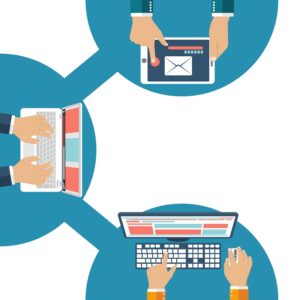The COVID-19 pandemic hit the world like a slow-moving wrecking ball. Despite warnings back in December of 2019, it wasn’t until mid-March of 2020 that governments were forced to take decisive action to slow the spread of this deadly disease. The fallout from these government-imposed lockdowns caused massive disruption to nearly everyone’s life. Overnight, virtually all school kids were forced to use online learning. Millions of people were out of work, while millions more learned how to work remotely. These moves roiled the equity markets and triggered supply chain issues we are still feeling nearly two years later. Thanks to government support for businesses and individuals, the economy quickly rebounded.
Unlike the government in the first wave of the pandemic, the response from healthcare professionals was swift. Not only did state and local health units swing into crisis mode, but they also managed to set up testing, treatment, and contact-tracing systems while developing materials to inform their citizens how to avoid the disease or quarantine to keep others safe. Within nine months of the first lockdown, there were multiple vaccines to inoculate people and reduce severe or deadly outcomes. Many public health departments used data models to predict spikes in cases and better prepare hospitals.
These techniques, strategies, and hard-learned lessons will help health departments and governments handle future health crises, from communicable diseases to identifying lead poisoning clusters.
Using Surveillance and Analysis to Create an Early Warning System
After governments were caught flatfooted at the start of the pandemic, monitoring the population via the healthcare system has grown in importance. Collecting data on growing illnesses can be vital in preventing a small number of cases from exploding into a severe problem. Other technologies can play an essential role in this. Some recent developments on this front include sensors in sewers that can detect pathogens in blackwater that are sensitive enough to detect diseases before there are cases in humans.
Surveillance can pinpoint other health-related issues. When there are cases of lead poisoning, it is essential to trace back to where the patient lives and test the water pipes. Discovering and replacing lead pipes can prevent further exposure and possible permanent intellectual disabilities in young children. With the opioid crisis affecting many parts of the United States, tracking overdoses has grown important. When a cluster of ODs is detected in one county, nearby hospitals should be notified to prepare to handle a possible surge in cases.
Having this type of early warning system can help officials take the necessary steps to mitigate potentially disruptive health-related issues before they become severely damaging to the public.
Sharing Data Is Important
Traditionally, health departments closely monitored the spread of diseases in their jurisdiction. This could be issues like the Zika virus, STDs/STIs (like AIDS or gonorrhea), or even the seasonal flu. However, health departments rarely or infrequently shared this information with other states or at the national level. This type of information can help the federal government handle a complex situation like COVID and improve the decision-making process. With more data, they can better allocate resources, develop mitigation strategies, and impose lockdowns if there is the potential of the healthcare system being overwhelmed.
Thankfully, improving the sharing of this information is something many states are working on upgrading. It will require investment into the IT infrastructure to safely and securely transmit this sensitive data.
Getting the Data Into the Right Hands
Having all the relevant information is vital for leaders to make the right decisions. For health officials at the state level, this means having access to real-time data from neighboring states and their own local public health units. This data-intensive approach will allow them to create and track the spread of contagions like viruses, manage healthcare capacity, and even use the data as a guide to return to normal.
Predictive modeling tools and artificial intelligence can point to where hot spots might arise while identifying patterns. This type of technology is already used to assist laboratories in comparing viruses on the genetic level. This task used to take days to accomplish, but the AI can get results in minutes.
Accommodating this massive influx of data will require changes to states’ and health organizations’ IT infrastructure. Utilizing cloud-based computing is essential because it allows instant access to anyone anywhere, it is secure, and has the flexibility to scale up or down depending on the crisis. Several healthcare systems and even the Department of Defense have developed innovative health information management systems that harness the power of the cloud to assist with the COVID response.
There are issues with data, however. The adage of “garbage in, garbage out” remains true. Care must be taken when inputting new data because errors will lead to the wrong assumptions and make any analytical models inaccurate and faulty. Data must be as “clean” as possible to avoid these issues.
Finally, these collection systems must have privacy and data security built-in. Since the start of the pandemic, there has been a staggering increase in cyberattacks, including ransomware and phishing schemes. Some systems anonymize the data by removing or replacing sensitive personal information. Other solutions include using encryption so that the data is unusable in the event of a breach. For security, access to this data should require multi-factor authentication to minimize brute force cyber-attacks.
The COVID-19 pandemic has claimed more than 800,000 American lives over the past 22 months. That is a staggering number, but could have been significantly higher if not for the decisive actions of leaders and heroic efforts by healthcare providers. Governments learned many lessons about handling such an unprecedented and disruptive crisis. But by using big data to create an early warning system, leaders can prevent outbreaks or mitigate future crises. After all, an ounce of prevention is worth a pound of cure. 
About the author: John Schaeffer leads SSG with a vision to apply his combined IT and management consulting experience to enhance public sector organizations. Previously, he worked on a consulting basis within financial services for Goldman Sachs, Prudential Investments, and Credit Suisse First Boston. John holds a Bachelor of Science degree from the Massachusetts Institute of Technology (MIT).
Related Items:
The Search for Better COVID Data Is Not Over
COVID Data Report Card: Mixed Results for Public Health
Putting Data to Work to Deliver the Best Care Everywhere
The post Using Big Data to Prevent a Future Health Crisis appeared first on Datanami.



0 Commentaires